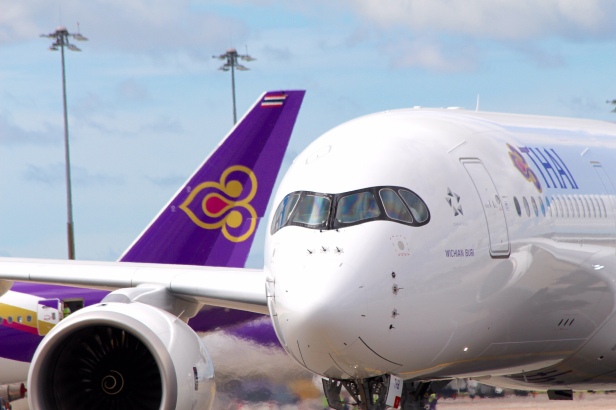Thai Airways Reports Full-Year Loss
by Andrew J Wood
 BANGKOK: THAI (TG) reported a disappointing loss despite increased passenger numbers, increased load factors, new fleet purchases and a reduction in the average age of the fleet. The national airline also introduced new direct long-haul flights to Vienna and increased regional coverage.
BANGKOK: THAI (TG) reported a disappointing loss despite increased passenger numbers, increased load factors, new fleet purchases and a reduction in the average age of the fleet. The national airline also introduced new direct long-haul flights to Vienna and increased regional coverage.
Thai Airways International (THAI) Pcl missed estimates with a net loss of 2.107 billion baht ($67.41 million) for its 2017 fiscal year, blaming aircraft maintenance, an impairment loss and higher fuel prices.
The airline, reported a profit of 15.14 million baht in 2016 and analysts’ had predicated a 2.6 billion baht profit for 2017. However this was not the case.
 THAI AIRWAYS 2017: Key Performance indicators at a glance
THAI AIRWAYS 2017: Key Performance indicators at a glance
THAI BAHT
🔺Revenue 192 billion +6.3%
🔺Profit -2.107 billion LOSS (LY +14.15 million)
🔺Cabin factor 79.2% +5.8%
🔺Passengers 24.6 million +10.4%
🔺Fuel Price +24.2%
🔺Forex -1.58 billion LOSS (LY+685 million)
🔺Maintenance 979 million (LY 1.32 billion)
🔺Impairment 3.19 billion (LY 3.63 billion)
🔺International Tourist arrivals 35.2m +9.9%
Thai Airways booked a one-time maintenance item of 550 million baht with a total of 979 million baht and impairment loss of assets and aircraft (depreciation) of 3.19 billion baht.
The carrier also booked 1.58 billion baht in foreign exchange losses in 2017, compared with a foreign exchange gains of 685 million baht in 2016. Average jet fuel price was 24.2 percent higher than the year before raising TG’s expenses.
Asian jet fuel differentials have reached a 10-year high in 2018 as demand has outpaced production.
Total revenue was up by 6.3 percent and reached 192 billion baht as the airline carried 24.6 million passengers in 2017, 10.3 percent more than it did in 2016.
TG reported a cabin factor – which measures how full its flights were – of 79.2 percent in 2018 – the highest in 10 years – up from 73.4 percent a year earlier. The Thai aviation industry is expected to expand from tourism and also the removal of the red flag related to safety concerns by the UN International Civil Aviation Organization in October last year.
A separate review by the US Federal Aviation Authority is expected to take place mid 2018, which the is hoped could open routes to the United States later in this year.
Thai Airways expects to receive five new Airbus A350-900 this year to fly intercontinental and regional routes.
The airline warned that competition from low-cost carriers and the upward trend of fuel prices were risks for the year ahead. Thai carriers have been struggling to make the most of a boom in tourism to Thailand, which expects a 6 percent rise in tourists to 37.55 million this year.
THAI and its subsidiaries reported a net loss of 2,072 million baht. Loss attributable to owners of the parent amounted to 2,107 million baht. Loss per share was 0.97 baht while last year’s profit per share was 0.01 baht.
 As of December 31, 2017, total assets were 280,775 million baht, a decrease of 2,349 million baht (0.8%) when compared to December 31, 2016. Total liabilities as of December 31, 2017 totalled 248,762 million baht, a decrease of 774 million baht (0.3%) when compared to December 31, 2016. Total shareholders’ equity amounted to 32,013 million baht, a decrease of 1,575 million baht (4.7%) resulting from loss in operating results.
As of December 31, 2017, total assets were 280,775 million baht, a decrease of 2,349 million baht (0.8%) when compared to December 31, 2016. Total liabilities as of December 31, 2017 totalled 248,762 million baht, a decrease of 774 million baht (0.3%) when compared to December 31, 2016. Total shareholders’ equity amounted to 32,013 million baht, a decrease of 1,575 million baht (4.7%) resulting from loss in operating results.
Thai Airway’s low-cost subsidiary Nok Air narrowed losses in 2017 to 1.85 billion baht from a 2.8 billion baht loss a year earlier and plans a turnaround by expanding international routes in China and India.
ANDREW J WOOD

